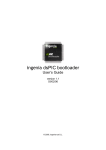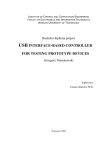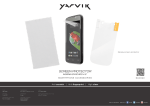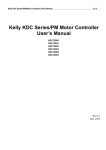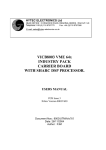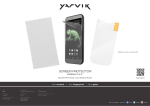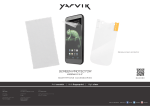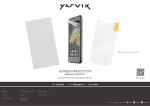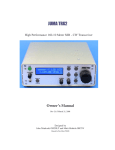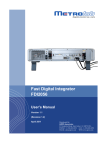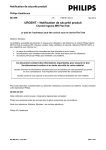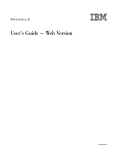Download iBL. User's guide
Transcript
iBL ingenia dsPIC bootloader Users’s guide 06/06/07 Version 1.4 © 2007, ingenia-cat S.L. iBL User’s guide Copyright and trademarks Copyright © 2007 ingenia-cat, S.L. Microchip, MPLAB and dsPIC are registered trademarks of Microchip Technology Incorporated in the U.S.A. and other countries Scope This document applies to ingenia dsPIC bootloader. Disclaimer This product is provided “as is”. ingenia-cat expressly disclaims any warranty of any kind, whether express or implied, including but not limited to, the implied warranties of merchantability, fitness for a particular purpose, or non-infringement. In no event shall ingenia-cat be liable for any incidental, special, indirect or consequential damages, lost profits or lost data, harm to your equipment, cost of procurement of substitute goods, technology or services, any claims by third parties (including but not limited to any defense thereof), any claims for indemnity or contribution, or other similar costs. User’s guide iBL Contents Overview ............................................................................. 5 What is a bootloader? ............................................................ 5 ingenia dsPIC bootloader .......................................................... 6 Bootloader package .............................................................. 6 ingenia dsPIC bootloader firmware ............................................ 6 Requisites........................................................................ 6 How it works? ................................................................... 7 Communication Protocol Description ....................................... 8 How to use it with another dsPIC30F ...................................... 10 Limitations ..................................................................... 11 ingenia dsPIC bootloader Graphic User Interface .......................... 12 Requisites....................................................................... 12 Setting up the Hardware ..................................................... 12 Loading and Writing programs .............................................. 15 Running and reconnecting ................................................... 16 The XML dsPIC list file ........................................................ 16 Appendix A. ingenia bootloader Source Code ................................. 19 Appendix B. Example of dsPIC list file ......................................... 20 3 User’s guide iBL Icons Following is shown the meaning of the icons that reader can find on this document. Information Provides the user with tips and tricks and other useful data. Warning Provides the user with important information. Omitting this warning may cause the device not to work properly. Critical Warning Provides the user with critical information. Omitting this critical warning may destroy the device. 4 User’s guide iBL 1 Overview This chapter introduces the bootloader strategy for MCUs. What is a bootloader? A serial bootloader is a firmware (software embedded in a hardware device) located into the non-volatile memory of a microcontroller unit (MCU) that allows in-circuit reprogramming of the device using its standard communication ports. Usually, the process to program a MCU implies the need of an expensive hardware device. Such devices, also called programmers, use the special purpose pins of the MCUs to access to the internal memory. Modifying the voltage applied to these pins, a read or write cycle of the memory could be performed. Moreover, the programmers also should incorporate a serial interface in order to allow the communications with the sender device (normally a Personal Computer (PC)). Together with the hardware programmer, comes software that helps the final user to send his own firmware through the serial port of the PC to the MCU. In the other hand, a serial bootloader is just a piece of code that works with the communication ports of an MCU and takes advantage of the capacity to write into his own non-volatile memory. This means that hardware programmer must be used at least once to load it into the MCU. Then, the user can reprogram the MCU as many times as required without the need of the hardware programmer. One of the main advantages of using a serial bootloader in a hardware device that contains a firmware, is that adds to it the capacity to be easily upgradeable (the user just needs a PC to update the firmware version). This procedure will save the cost of disassemble and send the device back to the factory. Chapter 1: Overview 5 User’s guide iBL 2 ingenia dsPIC bootloader Description of the ingenia bootloader (firmware + GUI). Bootloader package ingenia has developed a serial bootloader package specially focused on the dsPIC30F family of Microchip and tested with ingenia Communication Module (iCM4011). Mainly the bootloader package is divided into two parts: • • An open source firmware code (iBL) and, A Windows based graphical user interface (GUI). ingenia dsPIC bootloader firmware As explained above, the firmware must be loaded into the MCU using a hardware programmer. ingenia offers iCM4011 development kit based on dsPIC30F which comes with the bootloader already programmed inside. Contact ingenia for further information. The main features of ingenia’s bootloader firmware are: • • • • • Auto-Baud rate detection – The bootloader has the ability to adjust its own baud rate to the one used by the sender by mean of a synchronization protocol. Possibility of Read and Write Program (Flash) Memory – The bootloader is able to access to the whole non-volatile memory dedicated to program code. Possibility of Read and Write EEPROM Memory - The bootloader is able to access to the whole non-volatile memory dedicated to data. Possibility of Read and Write Configuration Registers - The bootloader is able to access to the configuration registers zone. Optimized assembler code – The firmware is implemented minimizing the used code size. Requisites The system requirements to use ingenia bootloader package is shown in the Figure 1. This system is composed by the following elements: • • • 6 A personal computer with ingenia dsPIC bootloader Graphic User Interface installed. A dsPIC30F Board with the firmware already loaded it and with a communications transceiver (i.e. iCM4011). The appropriate communication cable (USB, RS232, etc) according to the used transceiver. Chapter 2: ingenia dsPIC bootloader User’s guide iBL Figure 1: Typical System How it works? Conceptually the firmware can be seen as a flow of states (see Figure 2). Below there is a description of them and the conditions necessary to move from one to another. • • • • • • • Reset – When a power-up or a reset occurs the dsPIC enters in this state and jumps directly to the Baud Rate Detection. Baud rate detection – In this state, synchronization with the sender is performed in order to compute the used baud rate. After a time (one second if 7.3728 MHz crystal is used) if no synchronization is established a timeout occurs and the execution goes to the User program. If the baud rate is detected correctly the execution continues in the Wait Commands state. Wait Commands – During this state the dsPIC listens continuously the UART port. If a known command is received, the program will jump to the corresponding state (version, read, write, or user program). Otherwise will stay in this state indefinitely. Version – The version of the Firmware is sent through the UART and the execution returns to Wait Commands state. Read – A read memory operation is realized, the result is sent through the UART and the execution returns to Wait Commands state. Write – A write memory operation is realized and the execution returns to Wait Commands state. User Program – The program execution jumps to starting user program address (0x100) and therefore the bootloader ends. Figure 2: Flow State Diagram of the bootloader Appendix A: ingenia bootloader Source Code 7 User’s guide iBL Communication Protocol Description As explained in How it works?, the firmware is composed by a set of states that can be grouped into: • • Baud rate detection or synchronization between the two devices. Commands. Following there is a detailed explanation of the functionality of each group. Synchronization In order to achieve a correct synchronization, the remote device should send continuously the ASCII character ‘U’ (0x55) to the dsPIC. The representation of this character in binary is 01010101b giving the maximum frequency of transitions in a fixed baud rate (See Figure 3). Figure 3: Representation of the character 0x55 When the bootloader detects the first rising edge, starts a timer and looks for the next four rising edges. Once is detected the last edge one, the timer is stopped and the baud rate computed by means of a simple division. Commands The frame of all the commands used by the bootloader starts with an Identification Byte. The answer frame is always ended with acknowledge (ACK = 0x55) or non-acknowledge (NACK = 0xFF) but the Reset command. Firmware version command Check the major and minor version of the firmware. Command: Answer: Read command Read the content of a position of the memory, which could be FLASH, EEPROM or Configure registers addressed by a 24bits word. The answer is also a 24bits data word. Command: Answer: 8 Chapter 2: ingenia dsPIC bootloader User’s guide iBL Write command Carries out a write memory operation, which could be FLASH, EEPROM or Configure registers. The writing operation is done in row mode access (See Limitations for further information), thus you should specify the initial address, the length of the row and the whole row content. The frame ends with a CRC that is computed as the 256 module of all the data value addition. Command: Answer: or User Program command Force the user program execution, which should be located at address 0x100. Command: Answer: None Unknown command When an unknown command is received the bootloader sends a non-acknowledge. Answer: Appendix A: ingenia bootloader Source Code 9 User’s guide iBL RESET no BDR received from UART? no Timeout yes yes Compute Baudrate and configure UART USER CODE dsPIC sends ACK yes no BYTE received from UART? yes Reset command? no Version command? no Read command? no Write command? no dsPIC sends firmware version Receive address Receive Frame (address + N + data + CRC) dsPIC sends memory content CRC OK? no dsPIC sends NACK Assigns Erase/Write Row code and number of latches depending on memory region Erase Row (except if Config register) Load latches dsPIC sends ACK Write Row Figure 4: More detailed flowchart of the bootloader How to use it with another dsPIC30F The serial bootloader package comes with both, an MPLAB project and a compiled version of the assembler file valid for the dsPIC30F4011. However, if you want to use the firmware with another dsPIC30F family device you should change the project and recompile it. These are the steps to follow: 1. 2. 10 Start MPLAB and open the iBL.mcp project. In the option Select Device of the menu Configure, select the device of your system (see Figure 5). Chapter 2: ingenia dsPIC bootloader User’s guide iBL Figure 5: Selection of the device 3. 4. In the project window remove the default linker script (p30f4011.gld) and add the corresponding to your device (See Figure 6). After that you should be able to recompile the project normally. Figure 6: Modifying the linker script Limitations The bootloader firmware uses by default the alternate UART pins. If you want to use the main UART pins you should replace the initialization as follows: ; Uart init mov #0x8420, W0 ; W0 = 0x8420 -> 1000 0100 0010 0000b Appendix A: ingenia bootloader Source Code 11 User’s guide iBL mov W0, U1MODE ; Enable UART with Alternate IO, Auto Baud and 8N1 by ; Uart init mov #0x8020, W0 mov W0, U1MODE ; W0 = 0x8020 -> 1000 0000 0010 0000b ; Enable UART with Main IO, Auto Baud and 8N1 The writing of the EEPROM and Flash memories uses only the row mode access. Internally, the firmware erases and writes a whole row. Thus, to perform a correct writing operation the sender must: 1. Ensure the initial address of writing match an initial row position. 2. Send the data corresponding to the whole row. ingenia dsPIC bootloader Graphic User Interface ingenia dsPIC bootloader Graphic User Interface allows loading a program into a dsPIC, by using iBL (ingenia bootloader) firmware open source and an appropriate hardware platform (such as iCM4011). The following diagram shows this architecture: Figure 7: Architecture for using ingenia dsPIC bootloader Requisites Minimum recommended system requirements for ingenia dsPIC bootloader Graphic User Interface are: 9 9 9 CPU: Intel Pentium II (366 MHz or higher) with serial port for programming (USB also available if using iCM4011) Memory: 64 MB minimum Operating System: Windows 2000/XP Setting up the Hardware Setting up the port and the baud rate Before start the detection process of the dsPIC and bootloader firmware, you will have to select the serial COM port where you will plug your dsPIC platform and the baud rate to use for transferring data. The maximum allowed baud rate is 115200bps. If you are working on a noisy electric environment or your serial cable is longer than five meters, you may want to select a slower baud rate for transferring data. 12 Chapter 2: ingenia dsPIC bootloader User’s guide iBL Once you have configured the communications port, a message pops up alerting you to shut down your hardware platform (i.e. iCM4011) before start detection process (Figure 8). You must do this for synchronization reasons between the bootloader firmware saved into the dsPIC and this software. Figure 8: Starting ingenia dsPIC bootloader GUI Click on the ‘OK, my platform is shut down’ button when your platform is completely shut down. Check the ‘don’t remember me again’ option if you don’t want to be alerted next time you run ingenia dsPIC bootloader. Detecting the dsPIC Once you have shut down the hardware platform and configured the communications port, you can start the detection process of dsPIC and bootloader firmware. A message appears (see Figure 9) asking you to start your dsPIC platform. Figure 9: Detecting the dsPIC Few seconds after you start your platform, if the process succeeds, a message will pop up identifying the dsPIC detected and its bootloader firmware version. Make sure that your platform is shutted down before detection process starts. If the detection process fails, a message will pop up with an error code. Next is a table of the possible error codes and its description: Appendix A: ingenia bootloader Source Code 13 User’s guide iBL Error code Error type Error description XML syntax error An error has been found in your XML dsPIC list file regarding the memory regions description. Verify that you have correctly defined the three programming zones of the dsPIC. XML syntax error An error has been found in your XML dsPIC list file regarding the bootloader memory region description. Verify that you have correctly defined this programming zone of the dsPIC. -3 XML syntax error An error has been found in your XML dsPIC list file regarding the protected memory regions description. Verify that you have correctly defined these programming zones of the dsPIC. -4 Firmware detection failed ingenia's firmware has not been detected on the device, or its version is not valid. Contact ingenia at [email protected] for further information. -1 -2 -5 dsPIC not found -6 Error opening XML file Failed when opening XML dsPIC list file. Verify that file exists and its name and path have not been modified. Wrong dsPIC zones definition One or more dsPIC memory zones are not properly defined or its boundaries are not correct. Check documentation on how to add a new device (see Adding a new device) or contact ingenia at [email protected] for further information. Wrong protection of memory regions One or more protections of memory regions against overwriting are not properly defined or its boundaries are not correct. Check documentation on how to add a new device (see Adding a new device) or contact ingenia at [email protected] for further information. -7 -8 14 The dsPIC of the device has not been found on dsPIC list file. Check documentation on how to add a new device (see Adding a new device) or contact ingenia at [email protected] for further information. Chapter 2: ingenia dsPIC bootloader User’s guide iBL Loading and Writing programs When you finish the detection process, you can load as many programs as you want into your dsPIC. The loading & writing dialog window pops up (see Figure 10). To load a file, click on the folder button and browse for it. Click and browse for an HEX file Writeable memory zones of dsPIC Figure 10: Loading & Writing Dialog Supported file formats are Intel 16-bit and 32-bit hexadecimal object file format. Intel's Hex-record format allows program or data files to be encoded in a printable (ASCII) format. This allows viewing of the object file with standard tools and easy file transfer from one computer to another, or between a host and target. Writeable memory zones of a dsPIC can be divided into: • • • program flash write data EEPROM and configure registers ingenia dsPIC bootloader shows you the three zones and its associated range address accordingly with the detected dsPIC. Once you load the HEX file, it will automatically detect the programmed zones and check them in the appropriate check boxes. ingenia dsPIC bootloader may detect possible overwrite conflicts when you load an HEX file. The following table resumes the possible warning messages and its description. Message • code has data in bootloader addresses Appendix A: ingenia bootloader Source Code Description The HEX contains data in bootloader reserved region. ingenia dsPIC bootloader will never write on this zone. 15 User’s guide iBL • Your HEX file contains data in protected 'code' addresses • Your HEX file contains data in protected ‘EPROM’ addresses • Your HEX file contains data in protected ‘config’ addresses The HEX file contains data in protected regions. You can omit the warning and continue the writing process (the protected regions will not be overwritten). You can add protect regions of memory within a writeable zone by editing the ibl_dspiclist.xml file (see The XML dsPIC list file). Once you have loaded the file you can start the write process by clicking on the ‘start write’ button. Running and reconnecting After loading (writing) a program into the dsPIC, you can run it either: • manually restarting your platform (hardware disconnection/reconnection) • clicking on the run button of ingenia dsPIC bootloader GUI. or, In the first option, the program will start after bootloader firmware times out waiting for connection (see flowchart of Figure 4). In the second option, a User Program command will be sent to bootloader firmware which will force the user program execution. This option can only be used while keeping synchronization between device and bootloader firmware. After running the program, if you need to reconnect to the device you can click on the reconnect button and restart your hardware platform. COM and baud rates selected in the configuration process will be used. The XML dsPIC list file ingenia dsPIC bootloader can work with dsPIC30F family Digital Signal Controllers (for instance iCM works with dsPIC30F4011). The detection process of dsPIC (see Detecting the dsPIC) uses ibl_dspiclist.xml file to identify the controller and its features. This file is located in the installation folder and consists in a list of supported dsPICs (or devices). If the dsPIC that uses your platform doesn’t appear in that list, you can add them obeying the XML syntax used in the file. Next section will help you to do that. A DTD enclosed with the XML file will also help you check your XML syntax. For further information on writing XML files refer to http://www.w3.org/XML/ . A DTD ("Document Type Definition) is a set of declarations that conform to a particular markup syntax and that describe a class, or "type", of SGML or XML documents, in terms of constraints on the structure of those documents. Adding a new device Each dsPIC is named as a device in the XML dsPIC list file. A device is a description of a dsPIC. They are characterized by an identifier, a name and the number of instruction rows per page. The identifier (id tag) is the Microchip device ID (DEVID). The name (name tag) is the Microchip device name. The number of rows per page (rowsxpage tag) is related to erase and program process of dsPIC. In the dsPIC30F family must be always fixed to one. Within tags <device></device> you have to define three memory zones: 16 Chapter 2: ingenia dsPIC bootloader User’s guide iBL • • • code or programming, data, and configuration Code zone is represented with <memcode> tag. Data zone is represented with <memdata> tag. And configuration zone is represented with <memconfig> tag. In each zone you need to define the start address, the end address and the number of instruction per row as attributes of the tag. Also within memcode zone you have to specify bootloader region by using <bootloader> tag. The number if instructions per row are defined as follows: • Code: 32 instructions per row • Data: 16 instructions per row • Config: 1 instruction per row The bootloader region defines the zone where bootloader is located. This zone will be protected against overwrites, so be sure to define its start and end address properly (you will never be able to write code in this region). The XML dsPIC list file comes with bootloader region defined for iCM. If you are using a different platform, change it accordingly. The following example shows a complete definition of a device. <device id="0x0101" name="dsPIC30F4011" rowsxpage="1"> <memcode startaddress="0x000000" endaddress="0x007FFE" instructionxrow="32"> <boot loader startaddress="0x007E00" endaddress="0x007FFE"/> </memcode> <memdata startaddress="0x7FFC00" endaddress="0x7FFFFE" instructionxrow="16"/> <memconfig startaddress="0xF80000" endaddress="0xF8000B" instructionxrow="1"> </memconfig> Protecting zones of your dsPIC You can protect from overwriting memory regions of your dsPIC by using <protected> tag within a memory zone. To do that, specify the startaddress and the endaddress of the protected zone in the attributes of <protected> tag. <memconfig startaddress="0xF80000" endaddress="0xF8000B" instructionxrow="1"> <protected startaddress="0xF8000A" endaddress="0xF8000B"/> </memconfig> The following example protects the memory region starting at 0xF8000A and ending at 0xF8000B in the configuration zone. Appendix A: ingenia bootloader Source Code 17 User’s guide iBL You can protect as many regions as you want. If you try to write code on those regions, ingenia dsPIC bootloader will alert you about that and you will decide whether to proceed or not. See section Appendix B for a complete example of an XML dsPIC list file. 18 Chapter 2: ingenia dsPIC bootloader User’s guide iBL Appendix A. ingenia Code bootloader Source Last version of bootloader source code could be downloaded from ingenia-cat website (www.ingenia-cat.com). Appendix A: ingenia bootloader Source Code 19 User’s guide iBL Appendix B. Example of dsPIC list file <?xml version="1.0" encoding="iso-8859-1"?> <!DOCTYPE devices SYSTEM "ingeniadspicbootloader.dtd"> <devices> <device id="0x0040" name="dsPIC30F2010" rowsxpage="1"> <memcode startaddress="0x000000" endaddress="0x001FFE" instructionxrow="32"> <bootloader startaddress="0x001E00" endaddress="0x001FFE"/> </memcode> <memdata startaddress="0x7FFC00" endaddress="0x7FFFFE" instructionxrow="16"/> <memconfig startaddress="0xF80000" endaddress="0xF8000B" instructionxrow="1"> </memconfig> </device> <device id="0x01C1" name="dsPIC30F3011" rowsxpage="1"> <memcode startaddress="0x000000" endaddress="0x003FFE" instructionxrow="32"> <bootloader startaddress="0x003E00" endaddress="0x003FFE"/> </memcode> <memdata startaddress="0x7FFC00" endaddress="0x7FFFFE" instructionxrow="16"/> <memconfig startaddress="0xF80000" endaddress="0xF8000B" instructionxrow="1"> </memconfig> </device> <device id="0x0101" name="dsPIC30F4011" rowsxpage="1"> <memcode startaddress="0x000000" endaddress="0x007FFE" instructionxrow="32"> <bootloader startaddress="0x007E00" endaddress="0x007FFE"/> </memcode> <memdata startaddress="0x7FFC00" endaddress="0x7FFFFE" instructionxrow="16"/> <memconfig startaddress="0xF80000" endaddress="0xF8000E" instructionxrow="1"> <protected startaddress="0xF80000" endaddress="0xF8000E"/> </memconfig> </device> <device id="0x0080" name="dsPIC30F5011" rowsxpage="1"> <memcode startaddress="0x000000" endaddress="0x00AFFE" instructionxrow="32"> <bootloader startaddress="0x00AE00" endaddress="0x00AFFE"/> </memcode> <memdata startaddress="0x7FFC00" endaddress="0x7FFFFE" instructionxrow="16"/> <memconfig startaddress="0xF80000" endaddress="0xF8000B" instructionxrow="1"> </memconfig> </device> <device id="0x0198" name="dsPIC30F6014" rowsxpage="1"> <memcode startaddress="0x000000" endaddress="0x017FFE" instructionxrow="32"> <bootloader startaddress="0x017E00" endaddress="0x017FFE"/> </memcode> <memdata startaddress="0x7FF000" endaddress="0x7FFFFE" instructionxrow="16"/> <memconfig startaddress="0xF80000" endaddress="0xF8000B" instructionxrow="1"> </memconfig> </device> </devices> 20 Appendix B:Example of dsPIC list file User’s guide iBL References Microchip – “dsPIC30F Family Reference Manual”. DS70046 Microchip – “dsPIC30F Flash Programming Specification”. DS70102 Microchip – “dsPIC30F/33F Programmer’s Reference Manual”. DS70157 ingenia – “iCM4011. Product manual” Referencias 21





















